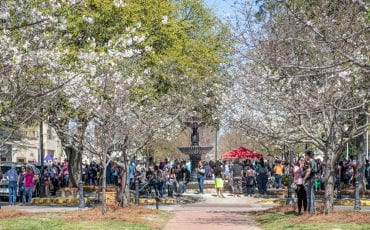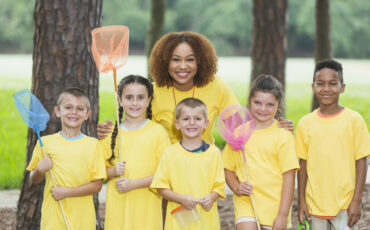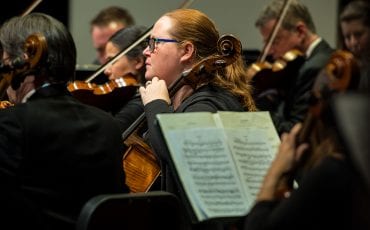Montessori: A Beginner’s Guide

A Montessori classroom is a little different. Instead of desks, students work at tables or sit on mats on the floor. The room is warm, inviting and ordered, with open workspaces and learning areas full of appealing activities. Children are curled up with books. Others collaborate together in soft voices. One child works intently with counting beads.
Students move around the room, choosing scientifically designed materials specific to their interest and development. You won’t find the teacher lecturing at the front of the class; instead, she is encouraging this student, observing that one, guiding them all. While it may seem a bit strange to some of us, the Montessori method of education has been practiced for more than 100 years.
Dr. Maria Montessori developed the system of education in 1907 after observing that children enjoy teaching themselves. Her theories are backed by 80 years of research conducted by Montessori educators all over the world. The Montessori program started as early education, but many schools have expanded the concept into elementary, middle, and even high school.
More than 5,000 schools in the United States and close to 100 private and public schools in Georgia use the Montessori method, according to the American Montessori Society. Georgia’s first Montessori school was Springmont School, founded as First Montessori School of Atlanta in 1963 with eight students. The school now educates students through middle school.
If you’re intrigued by the Montessori approach to education, here’s what you need to know about how it differs from traditional schooling.
Table of Contents
Multi-Age Classes
Multi-age groups are a standard element of the Montessori method. Children are grouped into three-year ranges, from 0-3, 3-6, 6-9, and 9-12. The younger children learn by listening and watching the older children, says Patricia Craft-Heuer, the Director of Education at Village Montessori. Older students act as mentors and role models while younger students are encouraged and supported.
The three-year age range also allows each child to develop at their own pace. “Montessori does not classify the children. It classifies the curriculum,” explains Dr. Feland Meadows, a leading expert on Montessori education and the Endowed Chair and Professor of Elementary and Early Childhood Education at Kennesaw State University.
Montessori Curriculum
Montessori schools cover the same subjects as traditional schools, but they are integrated across the curriculum. A study of the Egyptian pyramids might weave together history, language, the arts and geometry. “This approach shows the interrelatedness of all things and allows students to immerse themselves thoroughly in a topic,” says Marcy Krever, Senior Director of Marketing and Communications for the American Montessori Society.
Montessori students learn through direct experience and discovery, by seeing, touching, hearing and doing. During long blocks of uninterrupted work time, students engage in math, science, history, art, geography, language and music.
Kids learn more by being hands-on, experiential and investigative. Montessori encourages exploration of the natural world and an appreciation for the environment, inspiring kids to explore the outside, develop motor skills and boost their creativity. Children may spend more time outdoors, rather than just at recess.
Self-Paced Learning
The Montessori approach does not support a one-size-fits-all approach to education, where advanced students must wait for the rest to “get it,” and struggling students are forced ahead without grasping the lesson. “Learning thoroughly, at one’s own pace, results in a student who is ultimately stronger academically,” says Gail Pruitt Hall, the Director of Education at Northwoods Montessori School in Atlanta.
In Montessori schools, students learn at their developmental level. Teachers observe students’ learning styles, abilities, interests, and progress in the curriculum areas. Then they match each student with appropriate lessons and material. Under the teacher’s guidance, students are free to explore and learn according to their own interests.
Homework
The Montessori philosophy encourages families to engage in quality time together to inspire the child’s natural curiosity and nurture the child’s interests, Krever says. At home, children should work on household chores, helping a neighbor, or cozy up with a good book. Older elementary and middle school students may bring home project-based work that is tailored to the child’s interests. Students conduct their own research from articles and books, rather than relying on a textbook. Worksheets are avoided.
Assessing Student Progress
Many Montessori schools do not use grades. Montessori cultivates intrinsic motivation, engaging in learning for the joy of it, rather than the reward of a grade. “Respect for the child as a person, and as a learner with an individual pace, needs and interests is difficult to express with grades,” Pruitt Hall says. Teachers assess students through performance, evaluating projects and observations of student interests.
Older students demonstrate mastery through in-class presentations, student work portfolios, and sometimes standardized testing. Teachers observe academic skills as well as indications of social and personal development. According to Dr. Meadows, Montessori assessments are more accurate than standardized tests because the teacher observes her student’s progress in every area, every day.
More Than Academics
The Montessori method places strong emphasis on developing the whole child – social, emotional, physical and cognitive. It stresses character development and social skills, such as helpfulness, respect for self and others, and responsibility. Research shows Montessori students have advanced social and behavioral skills. They demonstrate a greater sense of justice and fairness. Several studies found that Montessori students developed greater levels of concentration and competence, which increases self-esteem, self-confidence and self-motivation.
Lauren Pilliner, a Brookhaven mom of two students at Northwoods Montessori, chose the school because of its emphasis on fostering a student’s independence and natural curiosity. She sees an increased willingness in her children to tackle tasks themselves.
Atlanta dad Brian Parks sends his kids to Arbor Montessori, where they’ve excelled socially, learning to communicate by speaking directly to adults, to articulate their emotions, and to “interact gracefully with younger and older children.”

The Reward of Early Education
Even a few years of Montessori early education makes a difference in students’ long-term success. “Montessori early childhood education promotes lasting effects on a child’s executive functioning and social-emotional intelligence,” says Alyssa Schwartz, Education Programs Director for Association Montessori International.
Blanche Martha of Lawrenceville attended Montessori as a child and now sends her own son to Oak Meadow Montessori. Martha credits her single year in Montessori as the foundation of her education. She describes the physical learning materials – the cylinder blocks, the bells, the bead chains – and how they accelerated her comprehension: “It made more sense after seeing it than just hearing it. Things like that stayed with me.”
Special Needs
Because a Montessori environment allows for freedom of choice and movement, children who are seen as “active” or “easily distracted” are often more successful than in other environments, Schwartz says. This makes Montessori a great fit for many special needs students. “We have autistic children and ADHD children in our classes,” says Dr. Meadows. “And after they have been there for a while, you can’t tell who they are.”
Find The Right School
Unfortunately, there is no trade mark on the term Montessori. Any school may call itself Montessori without ascribing to the system’s core philosophies. Look for Association Montessori International (AMI/USA) or American Montessori Society (AMS) recognition. However, many excellent Montessori schools are not accredited.
Research and visit a Montessori school to verify that the approach is the right one for your child. Ask about teacher requirements, and make sure staff members are certified Montessori educators. Ask to observe the classroom. Watch how students interact with the teachers, each other, and the environment. An authentic Montessori program will include mixed-age classrooms, hands-on learning materials, teachers who act as guides, uninterrupted work periods, and a focus on student choice and autonomy.
Check individual schools to see if they provide year-round programs. Some local schools do not offer summer programing for students, but many do.
If you want your child to continue through the elementary or middle school years, choose a school now that features that option. Many schools offer continuous education through age 15. Just this year, Montessori at Emory in Decatur added middle school, and now serve students from 15 months through eighth grade.
“We wanted to open up this wonderful education for older students,” says MaryAnn Barnhart, education coordinator at Montessori at Emory. The middle school curriculum remains faithful to the Montessori method of learning-by-doing while challenging students at an advanced cognitive level.
Public Montessori Options
In DeKalb County, Briar Vista Elementary, serving the Emory/North Druid Hills area, and Huntley Hills Elementary in Chamblee both have Montessori tracks. Sixteen years ago, Huntley Hills pioneered public Montessori education in the Atlanta metro area.
Beyond Montessori
When students leave Montessori, whether in first grade, sixth grade or high school, research suggests that they are well prepared for their future. Brian Parks attended Arbor Montessori as a child until age 11. “I can confidently say that our Montessori experience enabled us to flourish in diverse scholastic environments,” he says of himself and his classmates. Lauren Pilliner also attended a Montessori school as a child. “When I entered conventional schooling, I was more self-confident and independent than many of my classmates,” she says.
The research agrees. One study found a significant positive effect on high school students’ math and science scores five years after they transitioned out of Montessori classrooms. The Montessori teacher is not preparing the child for school,” Dr. Meadows says. “She is preparing the child for life.”
–Kyla Steinkraus
Learn more about differences between traditional and Montessori education here.







